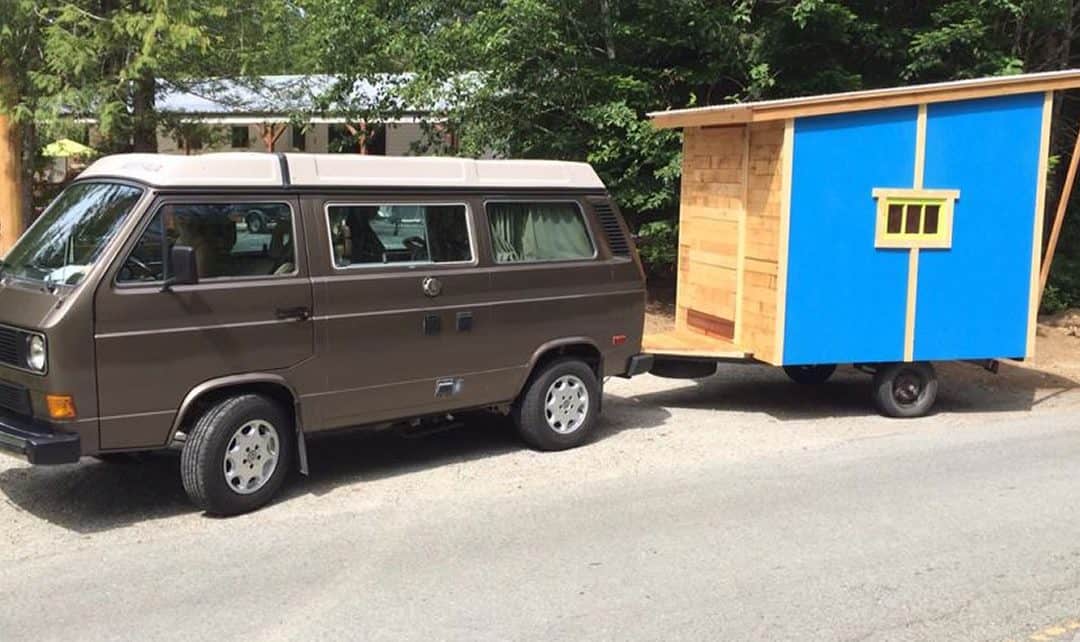Dave Koszegi, his wife Erin and their children Julia, Francesca and Matteo were on their annual Hornby Island, B.C. camping trip two summers ago when Dave happened to read Lloyd Kahn’s Tiny Homes on the Move. When the family saw the photos of Derek Diedricksen’s tiny house on wheels, Dave and Erin realized it would not only be a perfect addition to their overcrowded Volkswagen Westfalia camper van, it would also a great family project.
“Kids aren’t taught even the most basic things in school about finances or about housing – or how those go together,” says Koszegi, a sales rep with Re/Max of Nanaimo. But his children, who were 8, 7 and 4 when the family began actual construction in their driveway in January 2015, soon began to understand house construction through hands-on experience. They used graph paper to plan and recycled materials wherever possible, learning how to make every centimetre, kilogram and dollar count.
Their old van could only tow up to 1,000 pounds (453 kilos) and Diedricksen’s original tiny house weighed 1,500 pounds, so the family substituted 2x2s and 2x3s for 2x4s, screwing and gluing every piece for extra strength. Their final version is five-feet-wide, nine-feet-long and eight-feet-high not including the bathroom area, making it slightly larger than the original floor plan. “The whole side of the house opens to join the van, so it’s pretty versatile,” says Koszegi.
The busy young family found bits of time between dance practices and recitals, soccer games and client showings to work on the project together. “A builder might look at it and say, ‘Man, I could have done this in a weekend,’ but it took us six months’ worth of half an hour to an hour and a half at a time, gluing our fingers together,” he says. “Some people are buying houses and don’t know what a 2×4 is – now my kids actually understand better than some Realtors about what a piece of lumber is, what the dimensions mean, how it’s all put together and how all this stuff kind of works – and they’re little!”
“Tiny homes are a hot topic these days,” he says, noting that although his purpose-built “Hi, I’m Dave Koszegi” commercial has averaged about 100 yearly views in the five years it’s been online, the three-minute YouTube video of his family building its tiny home that he recorded on his phone has had more than 910 hits since it was posted a year ago. A short feature about the family and their tiny house on wheels that aired on CTV this spring got 5,400 hits in three days – more than a quarter of the population of Port Al
berni. “My social media person called me and cried ‘It’s viral!’” he says.
“If I was thinking about a tiny home as a principal residence I wouldn’t be thinking so compact. My tiny home on wheels is tiny,” says Koszegi, who’s 6ʹ5ʺ. But he thinks small homes are a great idea for people who want housing that’s more affordable and cheaper to operate, especially in recreational areas that have so many outdoor activities to enjoy. “There’s a place for 500-square-foot houses on fixed foundations, which is small but not ridiculous,” he says. “In a place like Port Alberni, we have low-priced houses, but condominiums or being attached are not all that popular. When you come all this way, you want your own little yard or whatever.”
But if municipalities had provisions for smaller houses – “and you’ve got to get Canada Mortgage and Housing Corp. to accept the idea – I think you’d have a form of housing that people would absolutely buy. It’d be more like buying a car,” Koszegi says. It would open a lot of doors for renters who can’t keep pets in their rental units, for example, or for retired couples who might not want to maintain larger houses while they holiday for months of the year, he says.
Koszegi grew up in Port Alberni, a city of about 18,000 two and a half hours northwest of Victoria on Vancouver Island. Now 46, he has been a Realtor for 26 years, maintaining a 25 to 35 per cent market share in the area, which has a total population of about 30,000. Although as a young man he loved everything about housing and enjoyed working in a hardware store, he says he’d “always also been a car nut,” and wasn’t sure whether he’d rather sell cars for a living. It was his marketing teacher who helped him to see that real estate could be more than an interesting profession.
“It also had a process, going to school and getting qualifications – and with old-world European parents it was important for me to have papers,” he says. “Now I go to work every day and I love it.”
Since the CTV spot about the family’s tiny house on wheels project aired, “I’ve had people follow us on the highway and pull us over to have a look, and clients waving.” He also received texts and pages from clients he hasn’t heard from in a while.
“I’ve been known for my high volume and a certain amount of competence, but people didn’t know my personal side,” Koszegi says. “I didn’t do it for that – I was thinking about my kids – but clients picked up on it. It’s made me more approachable and created all these points of connection that I didn’t expect,” he says.
The project “brings housing and cars together, so I ended up being able to do both of my passions,” he says. “I don’t golf or anything like that, just work and family time – and now if I’m not available people get what’s going on with me, and they don’t mind it.”


















